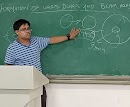Quantum
Why magnets are magnetic and why they are so rare??? Explaining the role of spin in it!!!
We all have played with this
mysterious metallic substance in our childhood!!!
Oh!!! They were really beautiful days
of life…. I’m really them a lot!!!
But have you ever wondered how these
tiny mysterious objects can attract chunks of iron pieces easily??? But at the
same time if we bring any other materials like aluminium or steel closer to it,
it doesn’t attract it. We all did that experiment right???
Big unsolved mystery for us right???
So let’s solve it….
It all begins with our beloved
electrons and their powerful ability of ‘spin’.
Spin is typical for elementary
particles, composite particles and nucleus of an atom. So, what is spin in
simple terms???
Spin in micro-world is the intrinsic
angular momentum of the particle. It is comparable with classical rotation. In
macro-world. But, here is a twist. In micro-world spin doesn’t represents the
type of rotation in macro-world. Here, rotation is completely ‘intrinsic’.
To know basics of quantum world, astronomy and space exploration you can check out my book "Through the wormhole" on amazon kindle.
To know basics of quantum world, astronomy and space exploration you can check out my book "Through the wormhole" on amazon kindle.
The unit of spin is reduced plank’s
constant (ħ). Spin is an integral factor for defining particles in micro-world. Want
to know more about micro-world particles???
Just click here…..
Now, you may ask; how this spin
effects magnetism???
Okay!!!…here we go…
It has been found that these
particles with spin behaves like tiny magnets. The objects which are made of
these particles possess that ‘magnetism’ power.
Why only a few materials are
magnetic???
See, to understand the reason
behind this firstly, we have to understand how spin works in electron orbital.
Each orbital contains two
electrons, each of them have opposite spin. For example, if one electron have 1
spin then other have -1 spin.
When an atom has completely filled
orbital then the electron of opposite spin cancels each other.
For an atom to be magnetic, it must
have half-filled orbitals so that the magnetic fields of individual electrons
reinforce one another. But, that doesn’t happen. Many materials have their
atoms arranged so that their magnetic fields cancel out rather than reinforcing
each other. This is the reason behind very few numbers of magnetic materials.
Do other particles like protons have
spin??? And if they have then why we are not discussing about them???
Yes, protons have spin and not only
that, atomic nuclei and composite particle also have spin. But, we don’t
consider their spin because magnetic field generated by electrons are much
stronger as compared to that of protons, neutrons or similar particles like
that.
Till now we are comparing particles
with tiny magnets. But, this comparison is not perfectly accurate……why??? That's the topic for another article!!!😉😉
Find out in my next article….. Why comparison of particles with tiny magnets is not accurate???
-Ratnadeep Das Choudhury
Founder and writer of The Dynamic Frequency
Thanks for Reading!!!
Check out my other blog posts!!!
Don't forget to share this post in your social media handles to enrich everyone's knowledge!!!
Also for latest updates of my posts join me on Twitter
See you Again!!!!!
-Ratnadeep Das Choudhury













0 Comments